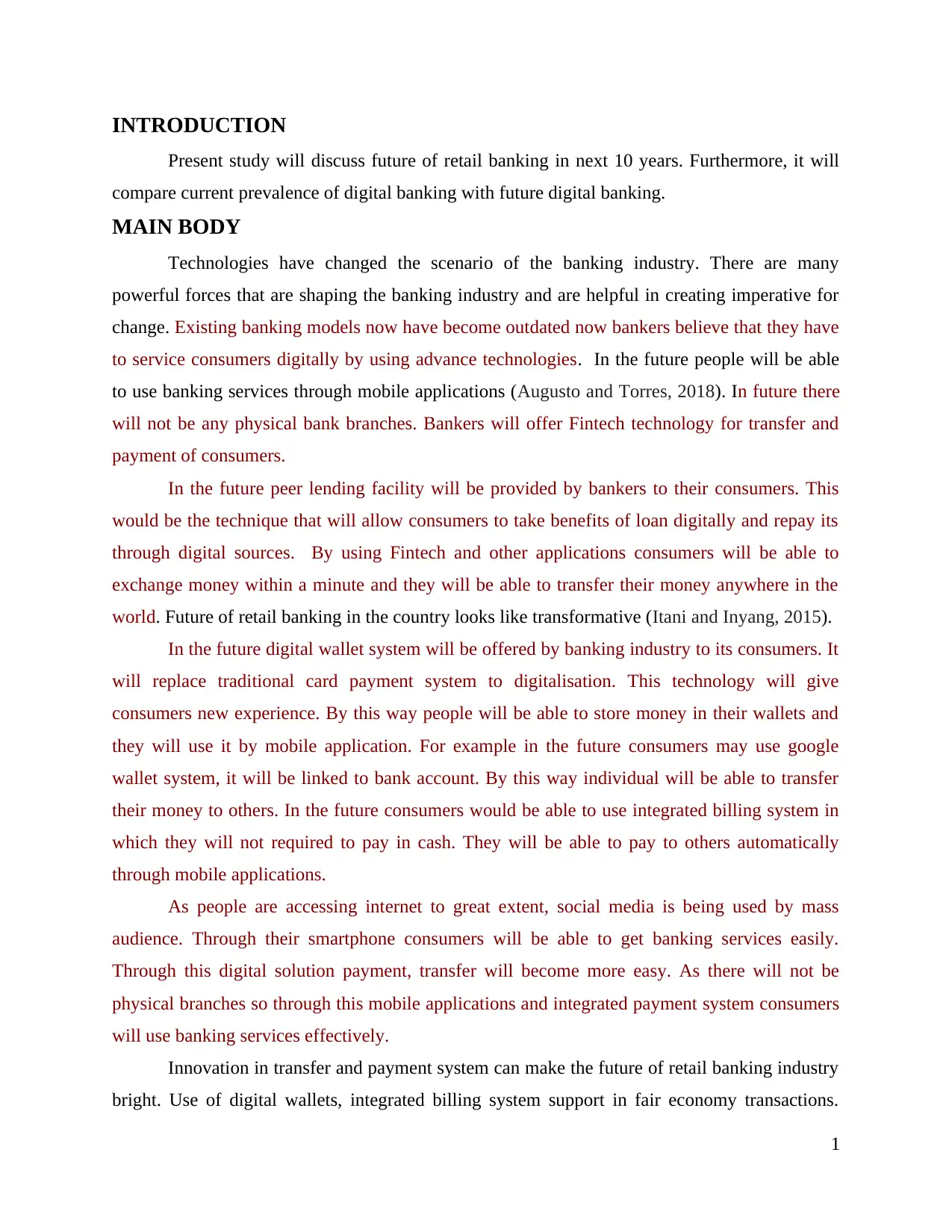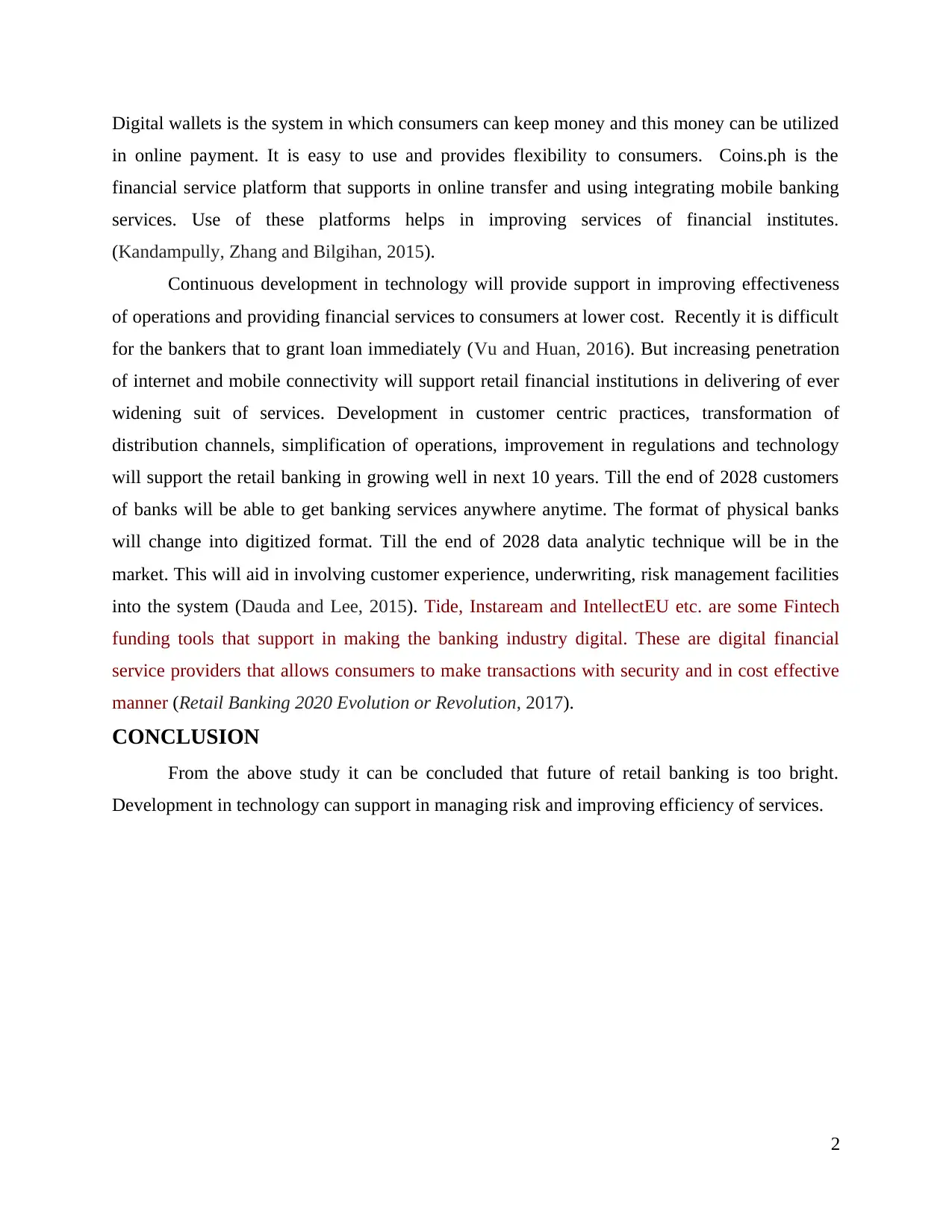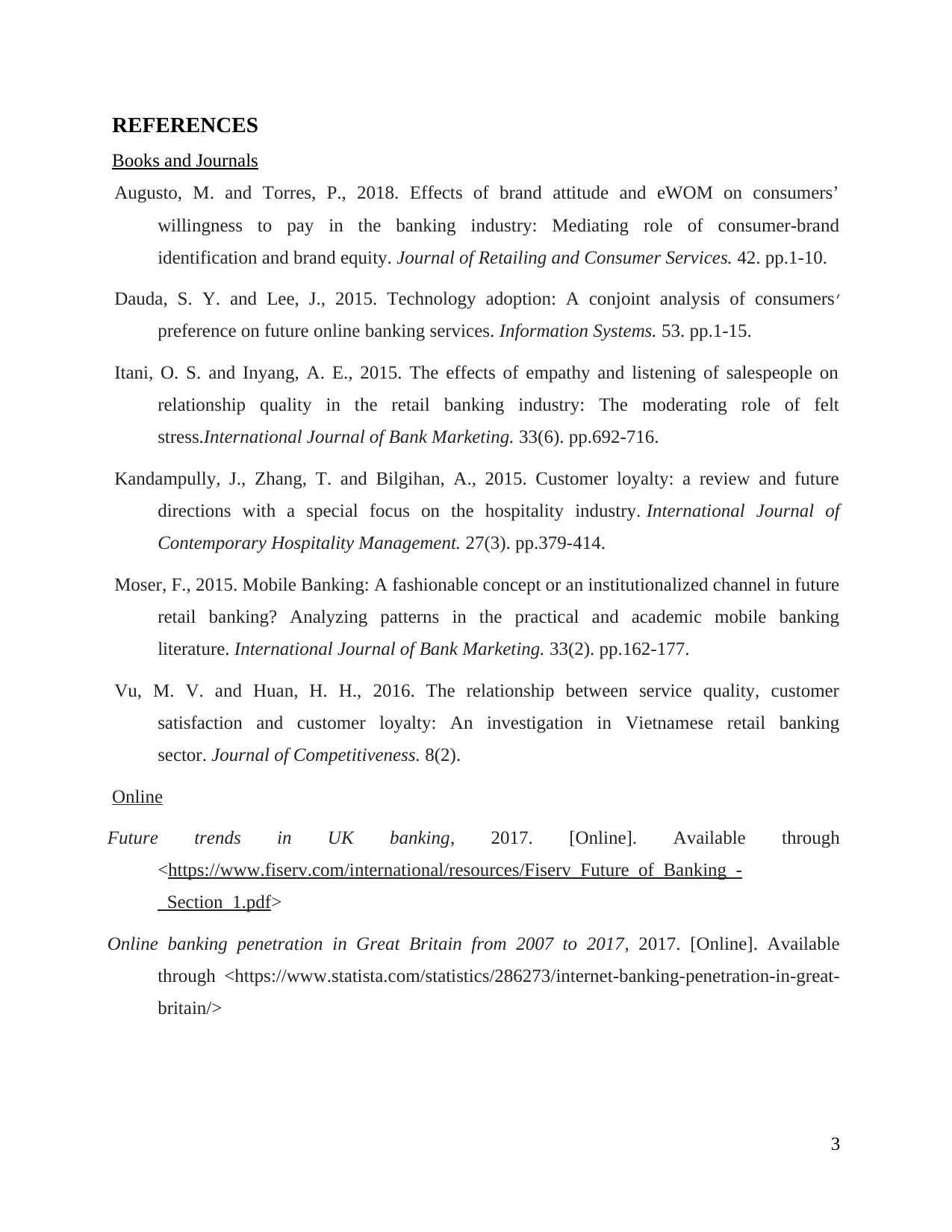Exploring the Future of Retail Banking in the Next Decade
VerifiedAdded on 2020/07/23
|6
|1097
|36
Report
AI Summary
This report provides an overview of the future of retail banking, focusing on the impact of technology and digital transformation over the next decade. It examines the shift towards digital banking, including mobile applications, Fintech solutions, and the decline of physical bank branches. The report highlights the adoption of digital wallets, integrated billing systems, and peer-to-peer lending platforms. It also discusses the role of data analytics, customer-centric practices, and the evolution of distribution channels. The study concludes that the future of retail banking is bright, with technology playing a crucial role in improving efficiency, managing risks, and providing financial services at a lower cost. References to supporting literature are provided to strengthen the arguments made in the report.

FUTURE OF RETAIL BANKING
Paraphrase This Document
Need a fresh take? Get an instant paraphrase of this document with our AI Paraphraser

Table of Contents
INTRODUCTION...........................................................................................................................1
MAIN BODY...................................................................................................................................1
CONCLUSION................................................................................................................................3
REFERENCES................................................................................................................................4
INTRODUCTION...........................................................................................................................1
MAIN BODY...................................................................................................................................1
CONCLUSION................................................................................................................................3
REFERENCES................................................................................................................................4

INTRODUCTION
Present study will discuss future of retail banking in next 10 years. Furthermore, it will
compare current prevalence of digital banking with future digital banking.
MAIN BODY
Technologies have changed the scenario of the banking industry. There are many
powerful forces that are shaping the banking industry and are helpful in creating imperative for
change. Existing banking models now have become outdated now bankers believe that they have
to service consumers digitally by using advance technologies. In the future people will be able
to use banking services through mobile applications (Augusto and Torres, 2018). In future there
will not be any physical bank branches. Bankers will offer Fintech technology for transfer and
payment of consumers.
In the future peer lending facility will be provided by bankers to their consumers. This
would be the technique that will allow consumers to take benefits of loan digitally and repay its
through digital sources. By using Fintech and other applications consumers will be able to
exchange money within a minute and they will be able to transfer their money anywhere in the
world. Future of retail banking in the country looks like transformative (Itani and Inyang, 2015).
In the future digital wallet system will be offered by banking industry to its consumers. It
will replace traditional card payment system to digitalisation. This technology will give
consumers new experience. By this way people will be able to store money in their wallets and
they will use it by mobile application. For example in the future consumers may use google
wallet system, it will be linked to bank account. By this way individual will be able to transfer
their money to others. In the future consumers would be able to use integrated billing system in
which they will not required to pay in cash. They will be able to pay to others automatically
through mobile applications.
As people are accessing internet to great extent, social media is being used by mass
audience. Through their smartphone consumers will be able to get banking services easily.
Through this digital solution payment, transfer will become more easy. As there will not be
physical branches so through this mobile applications and integrated payment system consumers
will use banking services effectively.
Innovation in transfer and payment system can make the future of retail banking industry
bright. Use of digital wallets, integrated billing system support in fair economy transactions.
1
Present study will discuss future of retail banking in next 10 years. Furthermore, it will
compare current prevalence of digital banking with future digital banking.
MAIN BODY
Technologies have changed the scenario of the banking industry. There are many
powerful forces that are shaping the banking industry and are helpful in creating imperative for
change. Existing banking models now have become outdated now bankers believe that they have
to service consumers digitally by using advance technologies. In the future people will be able
to use banking services through mobile applications (Augusto and Torres, 2018). In future there
will not be any physical bank branches. Bankers will offer Fintech technology for transfer and
payment of consumers.
In the future peer lending facility will be provided by bankers to their consumers. This
would be the technique that will allow consumers to take benefits of loan digitally and repay its
through digital sources. By using Fintech and other applications consumers will be able to
exchange money within a minute and they will be able to transfer their money anywhere in the
world. Future of retail banking in the country looks like transformative (Itani and Inyang, 2015).
In the future digital wallet system will be offered by banking industry to its consumers. It
will replace traditional card payment system to digitalisation. This technology will give
consumers new experience. By this way people will be able to store money in their wallets and
they will use it by mobile application. For example in the future consumers may use google
wallet system, it will be linked to bank account. By this way individual will be able to transfer
their money to others. In the future consumers would be able to use integrated billing system in
which they will not required to pay in cash. They will be able to pay to others automatically
through mobile applications.
As people are accessing internet to great extent, social media is being used by mass
audience. Through their smartphone consumers will be able to get banking services easily.
Through this digital solution payment, transfer will become more easy. As there will not be
physical branches so through this mobile applications and integrated payment system consumers
will use banking services effectively.
Innovation in transfer and payment system can make the future of retail banking industry
bright. Use of digital wallets, integrated billing system support in fair economy transactions.
1
⊘ This is a preview!⊘
Do you want full access?
Subscribe today to unlock all pages.

Trusted by 1+ million students worldwide

Digital wallets is the system in which consumers can keep money and this money can be utilized
in online payment. It is easy to use and provides flexibility to consumers. Coins.ph is the
financial service platform that supports in online transfer and using integrating mobile banking
services. Use of these platforms helps in improving services of financial institutes.
(Kandampully, Zhang and Bilgihan, 2015).
Continuous development in technology will provide support in improving effectiveness
of operations and providing financial services to consumers at lower cost. Recently it is difficult
for the bankers that to grant loan immediately (Vu and Huan, 2016). But increasing penetration
of internet and mobile connectivity will support retail financial institutions in delivering of ever
widening suit of services. Development in customer centric practices, transformation of
distribution channels, simplification of operations, improvement in regulations and technology
will support the retail banking in growing well in next 10 years. Till the end of 2028 customers
of banks will be able to get banking services anywhere anytime. The format of physical banks
will change into digitized format. Till the end of 2028 data analytic technique will be in the
market. This will aid in involving customer experience, underwriting, risk management facilities
into the system (Dauda and Lee, 2015). Tide, Instaream and IntellectEU etc. are some Fintech
funding tools that support in making the banking industry digital. These are digital financial
service providers that allows consumers to make transactions with security and in cost effective
manner (Retail Banking 2020 Evolution or Revolution, 2017).
CONCLUSION
From the above study it can be concluded that future of retail banking is too bright.
Development in technology can support in managing risk and improving efficiency of services.
2
in online payment. It is easy to use and provides flexibility to consumers. Coins.ph is the
financial service platform that supports in online transfer and using integrating mobile banking
services. Use of these platforms helps in improving services of financial institutes.
(Kandampully, Zhang and Bilgihan, 2015).
Continuous development in technology will provide support in improving effectiveness
of operations and providing financial services to consumers at lower cost. Recently it is difficult
for the bankers that to grant loan immediately (Vu and Huan, 2016). But increasing penetration
of internet and mobile connectivity will support retail financial institutions in delivering of ever
widening suit of services. Development in customer centric practices, transformation of
distribution channels, simplification of operations, improvement in regulations and technology
will support the retail banking in growing well in next 10 years. Till the end of 2028 customers
of banks will be able to get banking services anywhere anytime. The format of physical banks
will change into digitized format. Till the end of 2028 data analytic technique will be in the
market. This will aid in involving customer experience, underwriting, risk management facilities
into the system (Dauda and Lee, 2015). Tide, Instaream and IntellectEU etc. are some Fintech
funding tools that support in making the banking industry digital. These are digital financial
service providers that allows consumers to make transactions with security and in cost effective
manner (Retail Banking 2020 Evolution or Revolution, 2017).
CONCLUSION
From the above study it can be concluded that future of retail banking is too bright.
Development in technology can support in managing risk and improving efficiency of services.
2
Paraphrase This Document
Need a fresh take? Get an instant paraphrase of this document with our AI Paraphraser

REFERENCES
Books and Journals
Augusto, M. and Torres, P., 2018. Effects of brand attitude and eWOM on consumers’
willingness to pay in the banking industry: Mediating role of consumer-brand
identification and brand equity. Journal of Retailing and Consumer Services. 42. pp.1-10.
Dauda, S. Y. and Lee, J., 2015. Technology adoption: A conjoint analysis of consumers׳
preference on future online banking services. Information Systems. 53. pp.1-15.
Itani, O. S. and Inyang, A. E., 2015. The effects of empathy and listening of salespeople on
relationship quality in the retail banking industry: The moderating role of felt
stress.International Journal of Bank Marketing. 33(6). pp.692-716.
Kandampully, J., Zhang, T. and Bilgihan, A., 2015. Customer loyalty: a review and future
directions with a special focus on the hospitality industry. International Journal of
Contemporary Hospitality Management. 27(3). pp.379-414.
Moser, F., 2015. Mobile Banking: A fashionable concept or an institutionalized channel in future
retail banking? Analyzing patterns in the practical and academic mobile banking
literature. International Journal of Bank Marketing. 33(2). pp.162-177.
Vu, M. V. and Huan, H. H., 2016. The relationship between service quality, customer
satisfaction and customer loyalty: An investigation in Vietnamese retail banking
sector. Journal of Competitiveness. 8(2).
Online
Future trends in UK banking, 2017. [Online]. Available through
<https://www.fiserv.com/international/resources/Fiserv_Future_of_Banking_-
_Section_1.pdf>
Online banking penetration in Great Britain from 2007 to 2017, 2017. [Online]. Available
through <https://www.statista.com/statistics/286273/internet-banking-penetration-in-great-
britain/>
3
Books and Journals
Augusto, M. and Torres, P., 2018. Effects of brand attitude and eWOM on consumers’
willingness to pay in the banking industry: Mediating role of consumer-brand
identification and brand equity. Journal of Retailing and Consumer Services. 42. pp.1-10.
Dauda, S. Y. and Lee, J., 2015. Technology adoption: A conjoint analysis of consumers׳
preference on future online banking services. Information Systems. 53. pp.1-15.
Itani, O. S. and Inyang, A. E., 2015. The effects of empathy and listening of salespeople on
relationship quality in the retail banking industry: The moderating role of felt
stress.International Journal of Bank Marketing. 33(6). pp.692-716.
Kandampully, J., Zhang, T. and Bilgihan, A., 2015. Customer loyalty: a review and future
directions with a special focus on the hospitality industry. International Journal of
Contemporary Hospitality Management. 27(3). pp.379-414.
Moser, F., 2015. Mobile Banking: A fashionable concept or an institutionalized channel in future
retail banking? Analyzing patterns in the practical and academic mobile banking
literature. International Journal of Bank Marketing. 33(2). pp.162-177.
Vu, M. V. and Huan, H. H., 2016. The relationship between service quality, customer
satisfaction and customer loyalty: An investigation in Vietnamese retail banking
sector. Journal of Competitiveness. 8(2).
Online
Future trends in UK banking, 2017. [Online]. Available through
<https://www.fiserv.com/international/resources/Fiserv_Future_of_Banking_-
_Section_1.pdf>
Online banking penetration in Great Britain from 2007 to 2017, 2017. [Online]. Available
through <https://www.statista.com/statistics/286273/internet-banking-penetration-in-great-
britain/>
3

Retail Banking 2020 Evolution or Revolution, 2017. [Online]. Available through
<https://www.pwc.com/gx/en/banking-capital-markets/banking-2020/assets/pwc-retail-
banking-2020-evolution-or-revolution.pdf>
4
<https://www.pwc.com/gx/en/banking-capital-markets/banking-2020/assets/pwc-retail-
banking-2020-evolution-or-revolution.pdf>
4
⊘ This is a preview!⊘
Do you want full access?
Subscribe today to unlock all pages.

Trusted by 1+ million students worldwide
1 out of 6
Related Documents
Your All-in-One AI-Powered Toolkit for Academic Success.
+13062052269
info@desklib.com
Available 24*7 on WhatsApp / Email
![[object Object]](/_next/static/media/star-bottom.7253800d.svg)
Unlock your academic potential
Copyright © 2020–2025 A2Z Services. All Rights Reserved. Developed and managed by ZUCOL.





